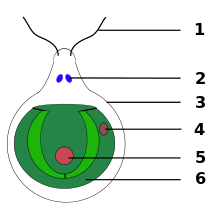Eyespot apparatus


The eyespot apparatus (or stigma) is a photoreceptive organelle found in the flagellate or (motile) cells of green algae and other unicellular photosynthetic organisms such as euglenids. It allows the cells to sense light direction and intensity and respond to it, prompting the organism to either swim towards the light (positive phototaxis), or away from it (negative phototaxis). A related response ("photoshock" or photophobic response) occurs when cells are briefly exposed to high light intensity, causing the cell to stop, briefly swim backwards, then change swimming direction. Eyespot-mediated light perception helps the cells in finding an environment with optimal light conditions for photosynthesis. Eyespots are the simplest and most common "eyes" found in nature, composed of photoreceptors and areas of bright orange-red red pigment granules.[1] Signals relayed from the eyespot photoreceptors result in alteration of the beating pattern of the flagella, generating a phototactic response.[2]
Microscopic structure
Under the
The eyespot apparatus of Euglena comprises the paraflagellar body connecting the eyespot to the flagellum. In electron microscopy, the eyespot apparatus appears as a highly ordered lamellar structure formed by membranous rods in a helical arrangement.[3]
In
Eyespot proteins
The most critical eyespot proteins are the photoreceptor proteins that sense light. The photoreceptors found in unicellular organisms fall into two main groups: flavoproteins and retinylidene proteins (rhodopsins). Flavoproteins are characterized by containing flavin molecules as chromophores, whereas retinylidene proteins contain retinal. The photoreceptor protein in Euglena is likely a flavoprotein.[3] In contrast, Chlamydomonas phototaxis is mediated by archaeal-type rhodopsins.[5]
Besides photoreceptor proteins, eyespots contain a large number of structural, metabolic and signaling proteins. The eyespot proteome of Chlamydomonas cells consists of roughly 200 different proteins.[6]
Photoreception and signal transduction
The Euglena photoreceptor was identified as a blue-light-activated adenylyl cyclase.[7] Excitation of this receptor protein results in the formation of cyclic adenosine monophosphate (cAMP) as a second messenger. Chemical signal transduction ultimately triggers changes in flagellar beat patterns and cell movement.
The archaeal-type rhodopsins of Chlamydomonas contain an all-trans retinylidene chromatophore which undergoes photoisomerization to a 13-cis isomer. This activates a photoreceptor channel, leading to a change in membrane potential and cellular calcium ion concentration.[5] Photoelectric signal transduction ultimately triggers changes in flagellar strokes and thus cell movement.[2]
